sigma
 AWS SNS (Simple Notification Service)
AWS SNS (Simple Notification Service)
Amazon Simple Notification Service (SNS) is a flexible, fully managed pub-sub messaging and mobile notifications service for coordinating the delivery of messages to subscribing endpoints and clients. With SNS you can fan-out messages to a large number of subscribers, including distributed systems and services, and mobile devices.
The Sigma IDE currently supports the following 3 types of SNS resources.
- SNS Topics (as triggers as well as for operations)
- Direct SMS via SNS (for operations)
- SNS Platform Applications (for operations)
SNS as a Trigger
A SNS topic can be used as a trigger for a lambda function within Sigma. For that, a SNS resource should be dragged from
the resources panel and dropped on top of the event parameter of the lambda handler. Then the SNS topic configuration
panel can be used to set a SNS topic as the trigger.
When a SNS topic is configured as a trigger to a Lambda function, that function is invoked each time a message is published to the topic. The structure of trigger event received by Lambda function is of the following format.
{
Records:[
{
EventSource:'aws:sns',
EventVersion:'1.0',
EventSubscriptionArn:'arn:aws:sns:us-east-1:111111111111:my_topic:9e72cbc4-8557-4c3e-97d5-fd805f7b9e1a',
Sns:{
Type:'Notification',
MessageId:'81559821-47a5-5241-abd2-cb26179d5550',
TopicArn:'arn:aws:sns:us-east-1:111111111111:my_topic',
Subject:'Message Subject',
Message:'Message Content',
Timestamp:'2018-02-21T10:46:16.596Z',
SignatureVersion:'1',
Signature:'LUxjiNldCBpq1WJYHM8l+3rSRiXHIdx4HgI4+IYkkzMh46ev5j0DKTw4AvJPd0XMbySVtSVA4hWYhe6sPg==',
SigningCertUrl:'https://sns.us-east-1.amazonaws.com/SimpleNotificationService-433026a4050d206028891664da859041.pem',
UnsubscribeUrl:'https://sns.us-east-1.amazonaws.com/?Action=Unsubscribe&SubscriptionArn=arn:aws:sns:us-east-1:111111111111:my_topic:9e72cbc4-8557-4c3e-97d5-fd805f7b9e1a',
MessageAttributes:{
custom_attr_1:{
Type:'Number',
Value:'1234'
},
'AWS.SNS.MOBILE.MPNS.Type':{
Type:'String',
Value:'token'
},
'AWS.SNS.MOBILE.MPNS.NotificationClass':{
Type:'String',
Value:'realtime'
},
'AWS.SNS.MOBILE.WNS.Type':{
Type:'String',
Value:'wns/badge'
}
}
}
}
]
}
Trigger Parameters
SNS triggers do not have any trigger specific parameters.
Setting the SNS topic
In SNS topic configuration panel, it is possible either to select an existing SNS topic or to define a new SNS topic.
Selecting an existing topic
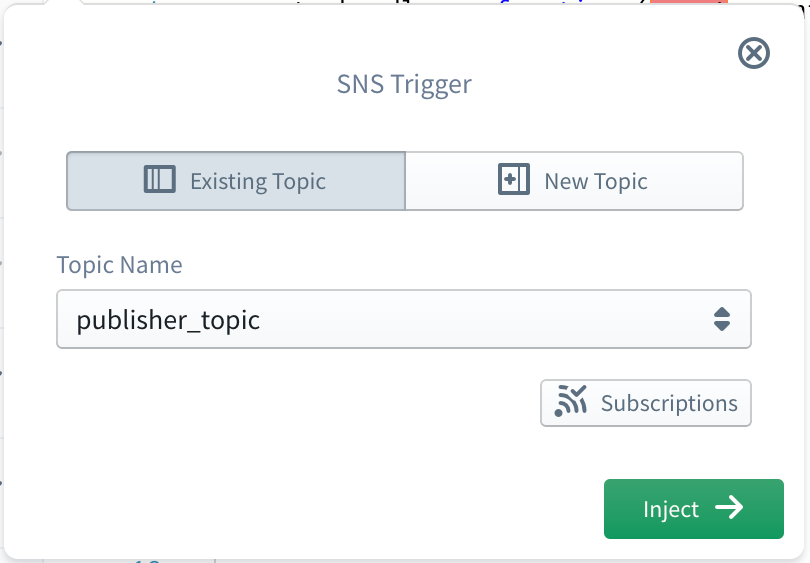
To select an existing topic, first go to the Existing Topic tab of the configuration panel. Then the Topic Name drop-down will be populated with all the already defined SNS topics in your AWS account for the current project region. You can simply select the required topic from that list.
Defining a new topic
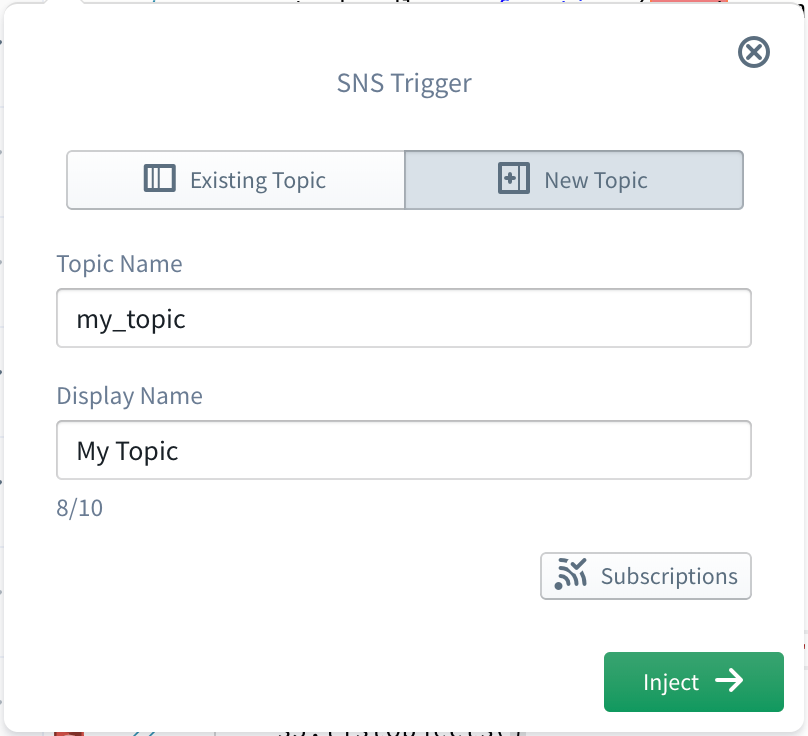
To define a new topic, first go to the New Topic tab of the configuration panel. Then a Topic Name should be provided, and this topic name must be non-empty and should contain only alphanumeric characters, hyphens (-), or underscores (_). Then a Display Name also should be provided and it should less than 10 characters in length.
Adding subscriptions to a topic
Sigma also provides the facility to add new subscriptions to an existing or a newly defined topic. For that, first click on the Subscriptions button below the topic configuration fields, which will open the subscriptions panel of the topic.
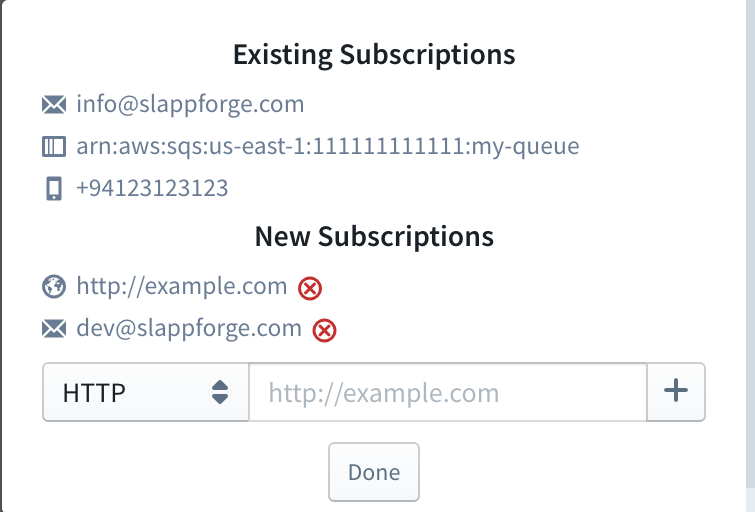
If you are using an existing topic which already has any subscriptions, they will be shown under Existing Subscriptions, and they cannot be changed. The new subscriptions you have defined through Sigma will be shown under New Subscriptions and any one of them can be removed by clicking on the remove button in-front.
To add a new subscription, first a subscription protocol should be selected from the drop-down on the left and then a suitable subscription endpoint should be specified in the right text box. Currently the following types of subscription protocols are supported.
- HTTP
- HTTPS
- Email JSON
- SQS
- Application (Platform Application)
- Lambda
- SMS
| Subscription Protocol | Endpoint Type | Example |
|---|---|---|
| HTTP | An HTTP URL | http://slappforge.com |
| HTTPS | An HTTPS URL | https://slappforge.com |
| A valid email address | info@slappforge.com |
|
| Email JSON | A valid email address | info@slappforge.com |
| SQS | ARN of a SQS queue | arn:aws:sqs:us-east-1:111111111111:my-queue |
| Application (Platform Application) | ARN of a SNS Platform Application | arn:aws:sns:us-east-1:111111111111:app/GCM/my-app |
| Lambda | ARN of a Lambda function | arn:aws:lambda:us-east-1:111111111111:function:my-function |
| SMS | A valid phone number | +94123123123 |
Once the subscription protocol and endpoint are defined, click the + button to add the subscription.
SNS for Operations
Although only the SNS topic resources can be used as triggers, all 3 types of SNS resources can be used inside Lambda code as operations. For that, a SNS resource should be dragged from the resources panel and dropped on the required line of the lambda code editor. Then the required Resource Type should be selected from the SNS resource configuration panel.
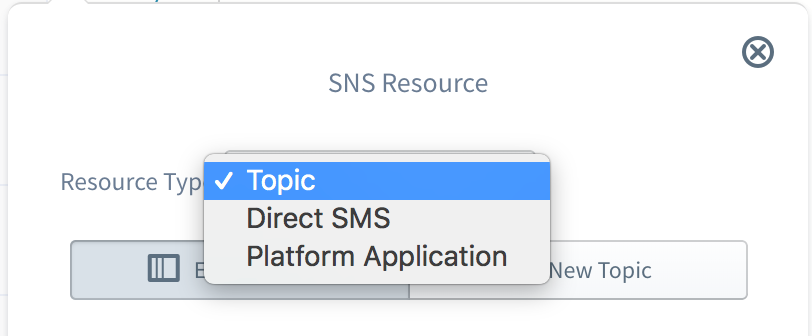
SNS Topic resource
When Topic is selected as the resource type, first an existing topic should be selected or a new topic should be defined for the operations. This procedure is exactly similar to setting a SNS topic when a SNS trigger is defined. Once the topic is configured, an operation to be injected can be selected from the Operation drop-down. Currently Sigma supports the following operations on SNS topics.
- Publish Message
- Get Topic Attributes
- List Topic Subscriptions
- Set Topic Attribute
- Add Topic Subscription
- Confirm Topic Subscription
- Remove Topic Subscription
Publish Message
Publish Message operation can be used to programmatically publish a message to a SNS topic. Following are the fields related to this operation.
| Field | Required | Supports Variables | Description |
|---|---|---|---|
| Subject | Subject of the message | ||
| Message | Content of the message | ||
| Message Attributes | A set of key-value pairs that should be set as message attributes. The type of the value can be String, String Array, Number or Binary. |
Get Topic Attributes
Get Topic Attributes operation can be used to programmatically retrieve the current attributes set for a SNS topic. This operation does not require any operation level parameters.
List Topic Subscriptions
List Topic Subscriptions operation can be used to programmatically retrieve the list of current subscriptions of a SNS topic. This operation does not require any operation level parameters.
Set Topic Attribute
Set Topic Attribute operation can be used to programmatically set the value of a SNS topic attribute. Following are the fields related to this operation.
| Field | Required | Supports Variables | Description |
|---|---|---|---|
| Attribute Type | Attribute to set the value for. This can be Policy, Display Name or Delivery Policy
|
||
| Attribute Value | Value to be set for the attribute |
Add Topic Subscription
Add Topic Subscription operation can be used to programmatically add a new subscription to a SNS topic. Following are the fields related to this operation.
| Field | Required | Supports Variables | Description |
|---|---|---|---|
| Subscription Protocol | Protocol of the subscription to be added. This can be HTTP, HTTPS, Email, Email JSON, SQS, Application, Lambda or SMS. |
||
| Endpoint | Subscription endpoint to be added |
Please refer Adding subscriptions to a topic section for more details on subscription protocols and related endpoints.
Confirm Topic Subscription
Confirm Topic Subscription operation can be used to programmatically confirm a subscription for a SNS topic. Following are the fields related to this operation.
| Field | Required | Supports Variables | Description |
|---|---|---|---|
| Confirmation Token | Confirmation token received by the subscription endpoint |
Remove Topic Subscription
Remove Topic Subscription operation can be used to programmatically remove an existing subscription from a SNS topic. Following are the fields related to this operation.
| Field | Required | Supports Variables | Description |
|---|---|---|---|
| Subscription ID | The ID of the subscription endpoint to be removed |
SNS Direct SMS resource
SNS Direct SMS resource can be used to send text messages directly to a phone number via SNS, without having to subscribe to a topic. Following are the fields related to this operation.
| Field | Required | Supports Variables | Description |
|---|---|---|---|
| Mobile Number | The mobile number to send the text message | ||
| Message | The message to be sent. If the message is longer than 160 characters, it will be treated as multiple text messages. | ||
| Message Type | The type of the message, which can be either Promotional or Transactional. Promotional type can be used for non-critical messages, such as marketing messages, where SNS optimizes the message delivery to incur the lowest cost. Transactional type can be used for critical messages that support customer transactions, such as one-time passcodes for multi-factor authentication, where SNS optimizes the message delivery to achieve the highest reliability. |
||
| Sender ID | The sender ID to be displayed as the message sender on the receiving device. This can contain up to 11 alphanumeric characters, including at least one letter and no spaces. |
SNS Platform Application resource
SNS Platform Application resource can be used to send notification messages to mobile apps and devices. Currently Sigma only supports operations on existing Platform Applications.
When Platform Application is selected as the resource type, first an existing platform application should be selected from the Application drop-down for the operations.
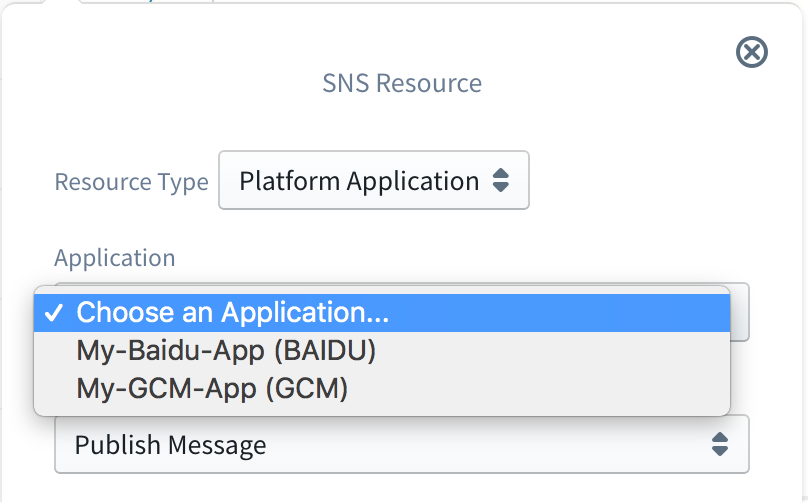
Once the application is selected, an operation to be injected can be selected from the Operation drop-down. Currently Sigma supports the following operations on SNS Platform Applications.
- Publish Message
- Create Endpoint
- Delete Endpoint
Publish Message
Publish Message operation can be used to programmatically publish a message to a platform application endpoint. Following are the fields related to this operation.
| Field | Required | Supports Variables | Description |
|---|---|---|---|
| Endpoint ID | ID of the endpoint to which the message should be sent | ||
| Subject | Subject of the message | ||
| Message | Content of the message | ||
| Message Attributes | A set of key-value pairs that should be set as message attributes. The type of the value can be String, String Array, Number or Binary. |
Create Endpoint
Create Endpoint operation can be used to programmatically add a new endpoint to a platform application. Following are the fields related to this operation.
| Field | Required | Supports Variables | Description |
|---|---|---|---|
| Token | Unique identifier created by the notification service for an app on a device. The specific name for Token will vary, depending on which notification service is being used. ADM, the device token equivalent is called the registration ID. | ||
| Custom User Data | Arbitrary user data to associate with the endpoint, which must be in UTF-8 format and less than 2KB | ||
| Endpoint Attributes | A set of key-value pairs that should be set as endpoint attributes |
Delete Endpoint
Delete Endpoint operation can be used to programmatically remove an existing endpoint from a platform application. Following are the fields related to this operation.
| Field | Required | Supports Variables | Description |
|---|---|---|---|
| Endpoint ID | ID of the endpoint to be deleted |